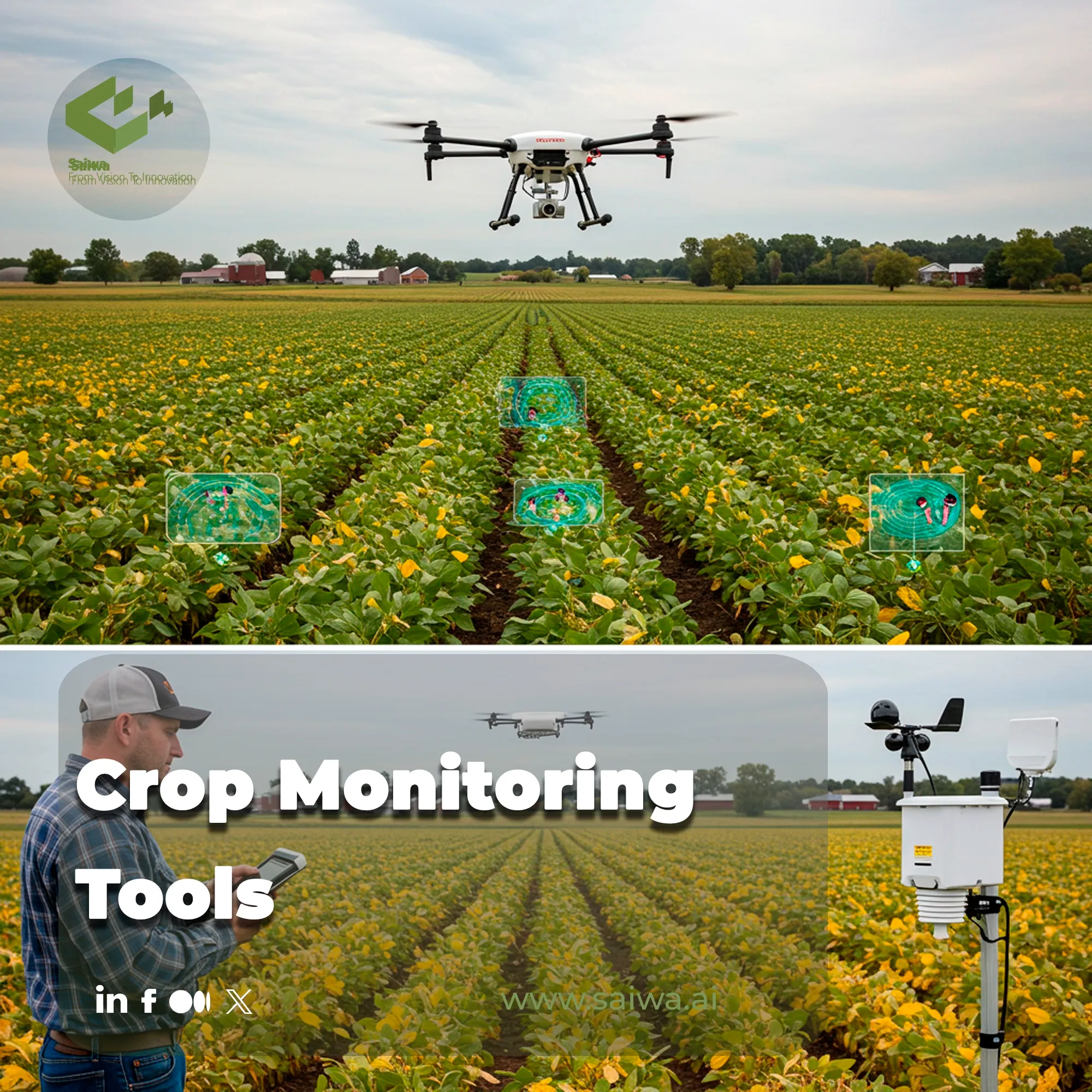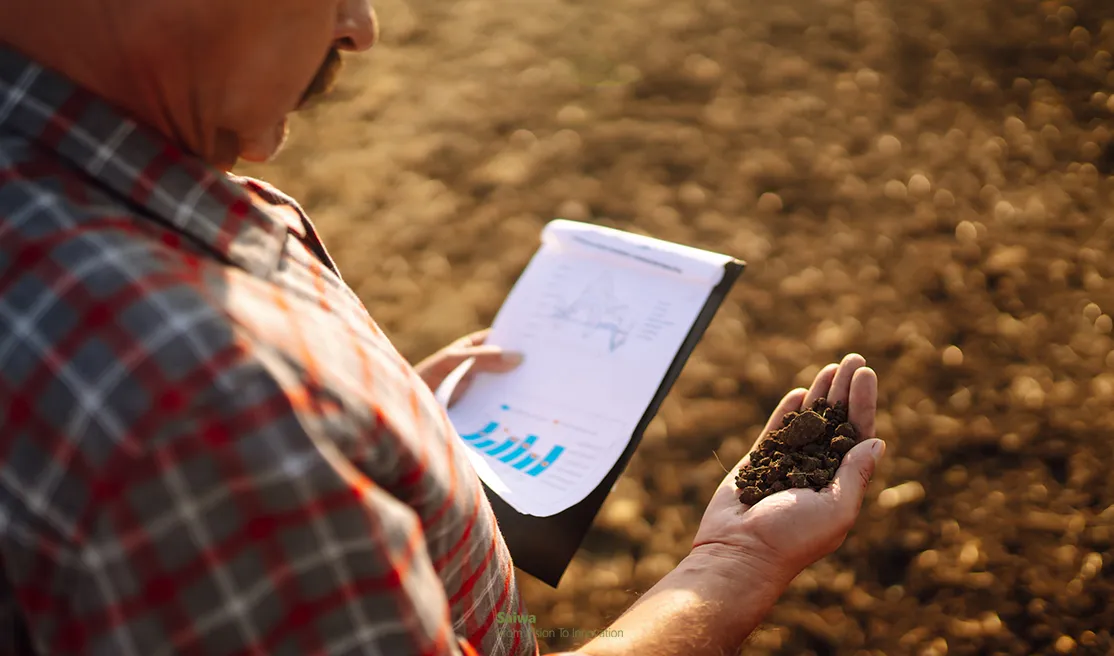Crop Monitoring Tools Explained: Key Technologies, Features, and Selection Tips

The evolution of precision agriculture is fundamentally shifting farm management from reaction-based remedies to proactive, data-driven strategies. This transition is powered by advanced analytical platforms that convert raw field data into strategic insights, enabling early interventions that were previously impossible.
For industry pioneers like Saiwa, the goal is to push this boundary further with AI-powered tools such as Sairone. This guide offers a technical breakdown of the core technologies, essential features, and key selection criteria to help you navigate this transformative landscape.
Understanding Crop Monitoring Technologies
Crop monitoring technologies are transforming modern agriculture by providing farmers with real-time insights into crop health, soil conditions, and environmental factors. This enables them to make data-driven decisions that enhance efficiency and sustainability. Remote sensing tools, such as satellites and drones, can capture large-scale field imagery to reveal variations in crop growth and detect early signs of stress. IoT-based sensors deliver precise measurements of soil moisture, nutrient content, and microclimate conditions. AI and machine learning platforms then analyze these data streams to generate clear recommendations for irrigation, fertilization, and pest control. Understanding and effectively integrating these technologies allows farmers to select the appropriate tools to increase productivity, minimize waste, and ensure long-term agricultural resilience.
Key Technologies Behind Crop Monitoring Tools
The effectiveness of modern Crop Monitoring Tools is rooted in their ability to synthesize data from multiple high-tech sources. To appreciate their function, it's essential to understand the individual components that form these integrated systems.
Satellite and Aerial Imagery: Drones and satellites capture high-resolution images, providing an invaluable macro-level view to identify spatial inconsistencies across fields.
Remote Sensing and Vegetation Indices: Sensors analyze reflected light from plants to calculate health metrics like NDVI, quantitatively assessing crop vigor.
IoT Sensors and In-Field Devices: Placed directly in the soil or canopy, these devices provide granular, real-time data on moisture, temperature, and nutrient levels.
Mobile and Web Applications: These platforms serve as the central hub, translating complex datasets into intuitive dashboards, maps, and actionable alerts.
Integrated Data Systems: The true power emerges from systems that merge all the above data streams into a single, cohesive operational picture.
Key Features of Crop Monitoring Tools
Beyond the hardware, the software's capabilities determine its real-world utility. When evaluating platforms, a specific set of features are non-negotiable for achieving comprehensive oversight of your agricultural operations.
Health Monitoring and Early Alerts
The cornerstone of any effective system is its capacity for continuous plant health monitoring. These tools should automatically detect anomalies and generate immediate alerts for biotic stresses like pests or abiotic issues like nutrient deficiency, enabling rapid, targeted responses.
Weather Forecasting and Soil Data Analysis
Integrating hyper-local weather predictions with real-time soil condition data allows for precise planning of irrigation, fertilization, and other crucial field activities.
Yield Prediction and Mapping
By analyzing current and historical performance data, advanced tools can generate highly accurate yield forecasts and create detailed maps that highlight high- and low-productivity zones.
Farm Activity Tracking and Field Logging
A digital log of all farm activities; from planting to harvest, is essential for operational analysis, compliance verification, and improving future crop cycles.
System Integration Capabilities
The tool must seamlessly integrate with existing farm machinery and management software to create a unified data ecosystem.

Selecting and Implementing a Crop Monitoring System
Integrating a crop monitoring system into daily operations requires both strategic planning and adaptability. The goal is not just to install new tools but to create a data-driven workflow that improves productivity, sustainability, and long-term decision-making. Successful implementation ensures that monitoring technologies become an active part of farm management rather than an isolated add-on.
Steps to Effective Implementation:
1.Assess Operational Needs: Begin by identifying the characteristics of your farm,crop varieties, field size, environmental conditions, and key challenges such as irrigation, nutrient management, or pest control.
2.Select Suitable Technologies: Match technologies to your operational scale and goals. Large farms may benefit from satellite-based insights, while smaller farms often achieve better results with drones or IoT-enabled sensors.
3.Integrate with Existing Practices: Smooth adoption requires compatibility with current systems and workflows. This may involve training staff, aligning new processes with existing schedules, and ensuring interoperability with your broader farm management platform.
4.Establish Data Protocols: Set up clear standards for data collection, storage, and analysis. Proper calibration of sensors, reliable connectivity, and access to advanced analytics platforms, such as Aether are critical for generating actionable insights.
5.Monitor, Evaluate and Improve: Implementation is not a one-time process. Continuously review the system’s performance, validate data accuracy, and refine workflows to maximize efficiency and ROI over time.
By following these steps, farmers and agronomists can transform raw data into practical strategies that drive higher yields, reduce input costs, and support sustainable farming practices.
The Importance of Crop Data Analysis in Modern Farming
Analyzing crop monitoring data is essential to transforming raw information into practical insights that lead to better agricultural decisions. Without proper analysis, even the most advanced monitoring systems offer little value. Here’s why crop analysis is so important:
- Optimized resource management: Data analysis helps determine precise irrigation and fertilization needs, reducing waste and improving efficiency of inputs.
- Early problem detection: By identifying patterns in crop growth or stress indicators, farmers can detect diseases, nutrient deficiencies, or pest outbreaks before they spread.
- Improved yield forecasting: Analyzing trends over time allows for accurate predictions of crop performance, supporting planning and market readiness.
- Sustainability and cost reduction: Insightful analysis minimizes unnecessary field operations, conserving water, energy, and chemicals.
- Continuous improvement: Comparing data across seasons helps refine strategies, leading to smarter, more adaptive farming practices over time.
How Sairone Enhances Crop Monitoring and Management
Standard systems show you data; Sairone tells you what to do with it. As a specialized AI solution, it elevates standard Crop Monitoring Tools by automating the most critical analytical tasks.
Using high-resolution drone imagery, Sairone moves beyond simple observation to deliver decisive actions, such as automated Weed detection for precision spraying and early pest identification. While Sairone offers a holistic agricultural solution, developers aiming to craft bespoke models for complex agricultural tasks can leverage specialized services within Saiwa's Fraime platform to build their own powerful tools.
Conclusion
Successfully adopting crop monitoring technology hinges on selecting a system that aligns with your specific agricultural needs and integration capabilities. The clear trajectory of this field is towards greater automation and AI-driven analysis, where platforms no longer just present data but deliver clear, actionable intelligence that drives efficiency and profitability.
Note: Some visuals on this blog post were generated using AI tools.
